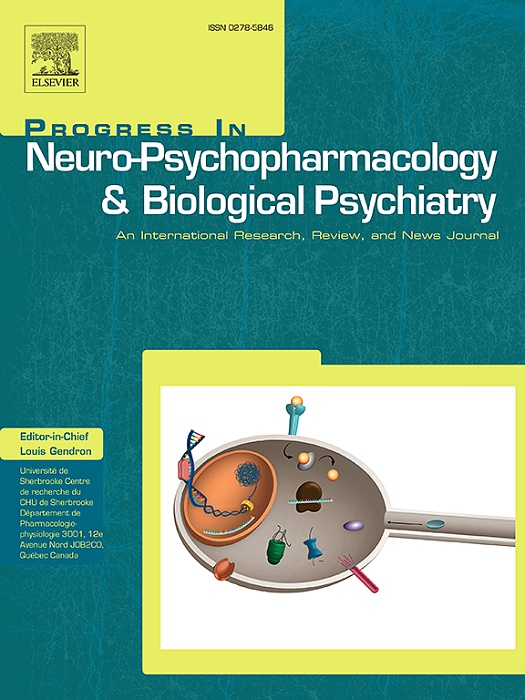经颅磁刺激治疗强迫症和创伤后应激障碍:对治疗效果、皮层目标和精神病理生理机制的全面系统回顾和分析。
IF 5.3
2区 医学
Q1 CLINICAL NEUROLOGY
Progress in Neuro-Psychopharmacology & Biological Psychiatry
Pub Date : 2024-09-16
DOI:10.1016/j.pnpbp.2024.111147
引用次数: 0
摘要
经颅磁刺激(TMS)是一种安全的非侵入性治疗技术。我们系统回顾了将经颅磁刺激应用于强迫症和创伤后应激障碍的随机对照试验(RCT),以分析其治疗效果,并探讨皮质靶点与精神病理生理学之间的关系。我们纳入了 47 项随机对照试验(35 项针对强迫症),发现强迫症的症状改善率为 22.7%,创伤后应激障碍的症状改善率为 29.4%。对强迫症和创伤后应激障碍分别进行了八项和四项皮质靶点研究,结果相似。双侧 dlPFC-TMS 的症状变化最大(强迫症 32.3%,4 项研究;创伤后应激障碍 35.7%,1 项研究),其次是右侧 dlPFC-TMS(强迫症 24.4%,8 项研究;创伤后应激障碍 26.7%,10 项研究)和左侧 dlPFC-TMS(强迫症 22.9%,1 项研究)。mPFC-TMS显示出令人鼓舞的结果,尽管证据有限(强迫症和创伤后应激障碍各有2项研究),而且创伤后应激障碍的研究结果也相互矛盾。尽管临床效果有所改善,但综述报告在皮层目标选择方面缺乏一致且可靠的理论依据,这揭示了 TMS 研究中的一个空白点,它使研究结果的解释变得复杂,并阻碍了 TMS 的发展和优化。未来的研究应采用假设驱动的方法,而不是仅仅依赖于成像研究的相关性,将神经生物学过程与情感、行为和认知状态结合起来,从而公正地对待人类经历和精神疾病的复杂性。本文章由计算机程序翻译,如有差异,请以英文原文为准。
Transcranial magnetic stimulation for obsessive-compulsive disorder and post-traumatic stress disorder: A comprehensive systematic review and analysis of therapeutic benefits, cortical targets, and psychopathophysiological mechanisms
Transcranial magnetic stimulation (TMS) is a safe non-invasive treatment technique. We systematically reviewed randomised controlled trials (RCTs) applying TMS in obsessive compulsive disorder (OCD) and post-traumatic stress disorder (PTSD) to analyse its therapeutic benefits and explore the relationship between cortical target and psychopathophysiology.
We included 47 randomised controlled trials (35 for OCD) and found a 22.7 % symptom improvement for OCD and 29.4 % for PTSD. Eight cortical targets were investigated for OCD and four for PTSD, yielding similar results. Bilateral dlPFC-TMS exhibited the greatest symptom change (32.3 % for OCD, N = 4 studies; 35.7 % for PTSD, N = 1 studies), followed by right dlPFC-TMS (24.4 % for OCD, N = 8; 26.7 % for PTSD, N = 10), and left dlPFC-TMS (22.9 % for OCD, N = 6; 23.1 % for PTSD, N = 1). mPFC-TMS showed promising results, although evidence is limited (N = 2 studies each for OCD and PTSD) and findings for PTSD were conflicting.
Despite clinical improvement, reviewed reports lacked a consistent and solid rationale for cortical target selection, revealing a gap in TMS research that complicates the interpretation of findings and hinders TMS development and optimisation.
Future research should adopt a hypothesis-driven approach rather than relying solely on correlations from imaging studies, integrating neurobiological processes with affective, behavioural, and cognitive states, thereby doing justice to the complexity of human experience and mental illness.
求助全文
通过发布文献求助,成功后即可免费获取论文全文。
去求助
来源期刊
CiteScore
12.00
自引率
1.80%
发文量
153
审稿时长
56 days
期刊介绍:
Progress in Neuro-Psychopharmacology & Biological Psychiatry is an international and multidisciplinary journal which aims to ensure the rapid publication of authoritative reviews and research papers dealing with experimental and clinical aspects of neuro-psychopharmacology and biological psychiatry. Issues of the journal are regularly devoted wholly in or in part to a topical subject.
Progress in Neuro-Psychopharmacology & Biological Psychiatry does not publish work on the actions of biological extracts unless the pharmacological active molecular substrate and/or specific receptor binding properties of the extract compounds are elucidated.

 求助内容:
求助内容: 应助结果提醒方式:
应助结果提醒方式:


